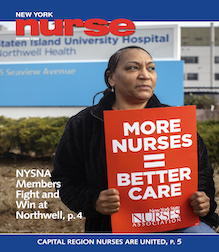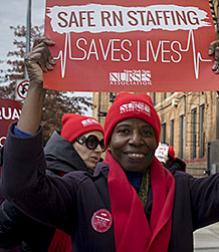In the past, nurses were under the impression that once negotiations were over and a new contract signed, the campaign ended. We would then plod through the remaining years, held captive to the terms and conditions of the agreement. This is no longer the case — so long as we are united and organized.
Enforcement = Unity + Action
In reflecting on our first-ever massive multi-employer bargaining campaign, we were able to create a united force, capable of confronting mega-medical systems as they swallowed up hospitals and made changes that further destabilized an already volatile environment. These corporations can no longer ignore us as we fight for humane healthcare; a fight that takes place in the legislature, in the streets, in contract campaigns, in every single patient care arena and in our own hearts.
The NYC hospitals had ratios and guidelines that were far more favorable than those in many other facilities — but still, there was room for improvement. Significantly, enforcement was a key element in our proposals as violations were rampant. Our strike authorization vote convinced them of our unity and resolve.
While the hospitals’ posture on “ratios” dominated their position, their agreement to add hundreds of new nurses, above and beyond existing budgeted positions, and to establish and expand incentivized Float Pools were key factors in the settlement. Most important, the ability, for the first time, to conduct Informational Pickets during the life of the agreement gave us an enforcement mechanism that we never had, combined with new contractual language that improves upon existing ratio/grids through Professional Practice Committees.
This final language was agreed to scant hours before the deadline to submit a 10-day notice. There’s a lot to be said for that kind of muscle.
Hospitals no longer see us as passive recipients of whatever new plan they put forth. Our contract campaigns go well beyond bread and butter issues and language. In fact, most recent victories have been won by direct involvement and action on the part of our members. Enforcing our rights and the rights of our patients to safe care is an ongoing struggle.
Campaign for Safe Staffing Law
The Hospital Association of New York (HANYS) publicly rejects “nurse to patient ratios” as a concept. However, we all know that hospital and nursing administration knows better than anyone that daily staffing is built around this very concept.
Hospitals state that their opposition stems from a view that ratios are “rigid,” that they need “flexibility,” that “legally imposed ratios will cause hospitals to close and other (ancillary staff) jobs to be lost.”
These arguments are identical to historic corporate arguments in favor of child labor, against workplace safety regulations, in opposition to providing healthcare benefits to workers, against increasing the minimum wage, even the opposition to the establishment of the 8 hour day. That fight was a rallying cry for Labor lasting well over 100 years and culminating in the Fair Labor Standards Act (FLSA) of 1937. Ironically, the fear mongering had no basis in fact, illustrated by unilateral actions taken by Ford Motors 100 years ago:
On January 5, 1914, the Ford Motor Company took the radical step of doubling pay to $5 a day and cut shifts from nine hours to eight — moves that were not popular with rival companies. However, seeing the increase in Ford’s productivity and a significant increase in profit margin (from $30 million to $60 million in two years), most soon followed suit.*
Many of us can recall this same corporate argument against restrictions to Mandatory Overtime. Prior to the law’s implementation, management across the state violated contract language restricting this provision with impunity. Contract language, while valuable, has limitations if there are no enforcement provisions. Obviously, getting management to agree to punish itself for contractual violations across a bargaining table is a major challenge.
Dignity and respect
Nurses’ commitment to defend every patient’s right to quality care begins the moment we step out of nursing school and certainly doesn’t end with a contract. It’s our job, as a collective body, to use the contract as a tool to struggle around the dignity and respect we all deserve, patients and caregivers.
For me, the most important element in this multi-employer process was the extraordinary activation of our members and lessons learned in how to forge unity among folks who had never before worked together. But nurses rose up: articulate, passionate, committed and visible. We are taking it to the next level, joining with our natural allies: patients, caregivers, labor and community — in our common struggle for social justice in healthcare and beyond.
*Ford Motor Company “Henry Ford’s $5-a-Day Revolution” , Ford, January 5, 1914.





